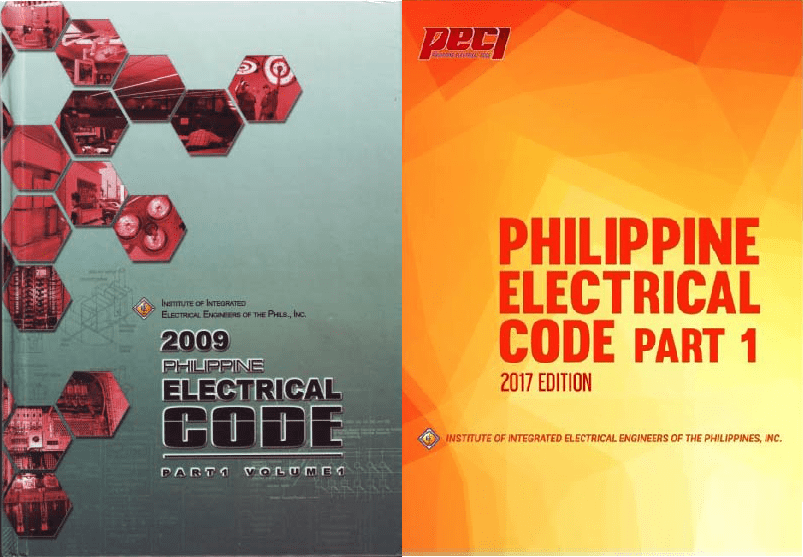The Philippines Electrical Code 2017 Edition, being a modified version of the 2017 edition of NFPA 70: National Electrical Code, went through extensive updates to incorporate sections and revisions not previously found in the PEC 2009 edition.
Below are some significant updates of the Philippines Electrical Code 2017 Edition:
1. Branch circuits — general provisions
Section 2.10.1.8(B) - Ground-Fault Circuit Interrupter Protection for Personnel, Other than Dwelling Units.
The GFCI requirements for receptacles at commercial and industrial applications have been expanded to require ground fault protection for circuits beyond 15 and 20 amperes at 250-volt applications. The PEC 2017 edition now mandates that at "other than dwelling units" all single-phase receptacles rated 250 volts to ground or less and up to 50 amperes shall be equipped with GFCI devices. Whereas three-phase receptacles rated 250 volts to ground or less and up to 100 amperes require GFCI protection devices.
2. Branch-circuit, feeder and service load calculations
Section 2.20.2.3 - Lighting Loads for Specified Occupancies.
Exception No. 1 of Section 2.20.2.3 was introduced in PEC 2017, which allowed lighting loads to be calculated based on energy code adopted by local authorities while meeting three listed conditions. New exception No. 2 added to PEC 2017 expands this allowance where an energy code is adopted and that energy code specifies an overall lighting density of less than 13.5 volt-amperes/13.5 square-meter. It permits the unit lighting loads in Table 2.20.2.3 for office and bank areas within the building to be reduced.
3. Services — Service Equipment Overcurrent Protection:
Section 2.30.7.6(C), Ground-Fault Protection of Equipment — Performance Testing.
The performance testing requirement for ground-fault protection system has been modified to ensure the testing is conducted by a qualified person(s) using a test process of primary current injection and that a written record of this testing is available to the authority having jurisdiction, Office of the Building Official / EE. This requirement also affects feeders listed under Section 2.15.1.10.
4. Overcurrent Protection — Fuses
Section 2.40.6.8 — Arc Energy Reduction.
The PEC 2017 expands the requirement for arc energy reduction where fuses rated 1,200 amperes or higher are installed. This is similar to Section 2.40.7.8 to reduce incident energy for circuit breakers rated 1,200 amperes and higher.
This new requirement will reduce incident energy to which an electrical worker or maintenance personnel could be exposed when working on the load side of an overcurrent device — in this case, fusible switches. Unfortunately, no fusible switches currently available in the market with this feature, like what is available in the market for circuit breakers. This will impact the installation costs where instead of a low-cost fuse, a more expensive circuit breaker with energy reduction maintenance switch has to be considered.
5. Overcurrent Protection — Circuit Breakers
Section 2.40.7.8 — Arc Energy Reduction.
The subsection (B), which covers requirements for reducing clearing time on breakers rated 1,200 amperes or more, describes three new permissible methods. Two of the three new means involve using an "instantaneous trip setting" or "instantaneous override" that is less than the available arcing current, while the third option allows "an approved equivalent means". This section was added to PEC 2017 to reduce incident energy for circuit breakers rated 1,200 amperes and higher to limit the arc-flash energy.
6. Emergency Systems — Tests and Maintenance
Section 7.0.1.3(F) — Temporary Source of Power for Maintenance or Repair of the Alternate Source of Power.
According to the new subsection (F), if the emergency system relies on a single alternate source of power, which will be disabled for maintenance or repair, the emergency system shall include permanent switching means to connect a portable or temporary alternate source of power, which shall be available for the duration of the maintenance or repair. The permanent switching means to connect a portable or temporary alternate source of power shall comply with five provisions listed in the code.
It shall be permissible to use manual switching to switch from the permanent source of power to the portable or temporary alternate source of power and to use the switching means for connection of a load bank.
7. Emergency System — Circuit Wiring
Section 7.0.2.1(D) — Fire Protection.
According to modified subsection (D), emergency systems shall meet the additional requirements in (D)(1) through (D)(3) in the following occupancies:
(1) Assembly occupancies for not less than 1,000 persons.
(2) Buildings above 23 meters in height.
(3) Health care occupancies where persons are not capable of self-preservation.
(4) Educational occupancies with more than 300 occupants.
The subsection 7.0.2.1(D) in PEC 2017 was expanded by adding Health care and Educational occupancies to the requirements for fire protection of emergency system feeders in addition to high-rise buildings and buildings with high occupancy loads.
8. Emergency Systems — Control of Emergency Lighting Circuits
Section 7.0.5.6 — Branch Circuit Emergency Lighting Transfer Switch.
A new definition along with provisions and requirements have been added to the PEC 2017 edition as part of the reason to introduce the new branch-circuit emergency lighting transfer switches into the PEC. Emergency lighting loads supplied by branch circuits rated at not greater than 20 amperes shall be permitted to be transferred from the normal branch circuit to an emergency branch circuit using a listed branch circuit emergency lighting transfer switch. The mechanically held requirement of Section 7.1.1.5(C) shall not apply to listed branch circuit emergency lighting transfer switches.
9. Interconnected Electric Power Production Sources
Section 7.5.4 — Microgrid Systems.
The microgrid systems also referred to as "intentionally islanded systems" and "stand-alone systems" have been getting a lot of recognition in recent years as a way to reduce energy usage, lower cost and, more importantly, add resiliency against the loss of utility power. Microgrids are small wiring systems consisting of generation, energy storage and load(s) or any combination thereof that shall be permitted to disconnect from the primary source of power or other interconnected electric power production sources and operate as a separate microgrid system.
